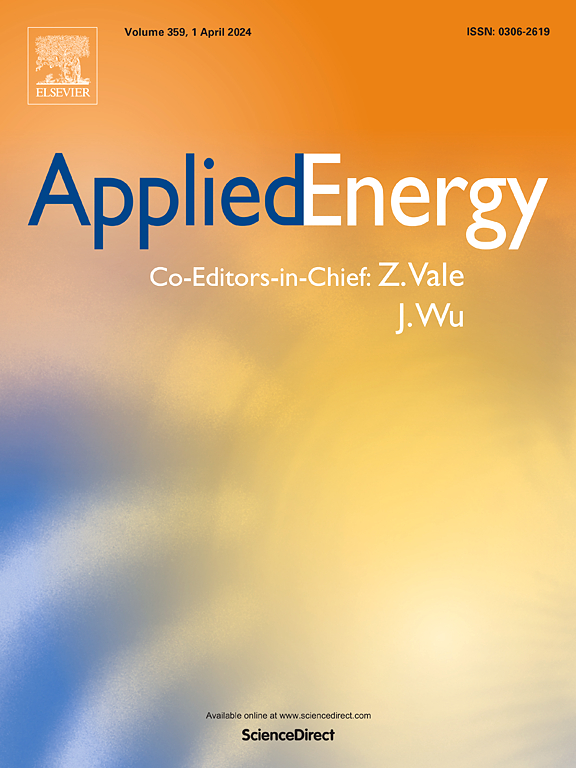A hybrid correction framework using disentangled seasonal-trend representations and MoE for NWP solar irradiance forecast
IF 10.1
1区 工程技术
Q1 ENERGY & FUELS
引用次数: 0
Abstract
Day-ahead solar irradiance forecast holds important value for optimizing energy utilization within the power system and ensuring stable grid scheduling. The forecast outputs of numerical weather prediction (NWP) are widely acknowledged as one of the indispensable data sources for day-ahead solar irradiance forecast tasks. In previous studies, post-processing methods have generally been employed as correction models to enhance the accuracy of NWP solar irradiance forecasts. However, irradiance sequences contain complex mixed patterns and exhibit various seasonal periodic differences. Based on the analysis of NWP global horizontal irradiance (GHI) error characteristics in this study, errors in NWP GHI forecasts also show obvious seasonal variations. Given these issues, it is challenging for a single correction model to achieve good correction performance and strong seasonal robustness. Therefore, this paper proposes a hybrid model comprising representation learning module, feature sparse activation module, and encoder-decoder-based correction module to address the aforementioned problems. A contrastive-learning-based representation learning module named CoST is introduced to learn disentangled seasonal features and trend features of irradiance sequences. A learnable mixture-of-experts (MoE) layer is adopted to sparsely activate the seasonal-trend features that contribute more to improving correction accuracy. The encoder-decoder-based correction module takes the sparsely activated seasonal-trend features as inputs, achieving the final corrected NWP GHI forecasts. The correction performance of the proposed method was validated on both publicly available datasets and actual field dataset. The results for various datasets show that our proposed CoST-MoELSTM model achieves the highest improvement for NWP forecasts, with increases of 29.82 %, 36.54 %, and 26.58 %. Additionally, we conducted a detailed analysis of the correction performance of CoST-MoELSTM across different seasons, indicating its superior seasonal robustness.
NWP太阳辐照度预报中使用解纠缠季节趋势表示和MoE的混合校正框架
日前太阳辐照度预报对于优化电力系统内的能源利用和保证电网调度的稳定具有重要的价值。数值天气预报(NWP)的预报结果被广泛认为是日前太阳辐照度预报工作不可或缺的数据来源之一。在以往的研究中,一般采用后处理方法作为校正模式来提高NWP太阳辐照度预报的精度。然而,辐射序列包含复杂的混合模式,并表现出不同的季节性周期性差异。基于本研究对NWP全球水平辐照度(GHI)误差特征的分析,NWP全球水平辐照度预报误差也呈现出明显的季节变化。考虑到这些问题,单个修正模型要达到良好的修正性能和较强的季节鲁棒性是具有挑战性的。因此,本文提出了一种由表示学习模块、特征稀疏激活模块和基于编码器-解码器的校正模块组成的混合模型来解决上述问题。引入了一种基于对比学习的表示学习模块CoST来学习光照序列的解纠缠季节特征和趋势特征。采用可学习的混合专家层(MoE)稀疏激活更有助于提高校正精度的季节趋势特征。基于编码器-解码器的校正模块将稀疏激活的季节趋势特征作为输入,实现最终校正的NWP GHI预测。在公开数据集和实际现场数据集上验证了该方法的校正性能。对不同数据集的结果表明,我们提出的成本- moelstm模型对NWP预测的改进程度最高,分别提高了29.82 %、36.54 %和26.58 %。此外,我们对不同季节的CoST-MoELSTM校正性能进行了详细分析,表明其具有较好的季节稳健性。
本文章由计算机程序翻译,如有差异,请以英文原文为准。
求助全文
约1分钟内获得全文
求助全文
来源期刊

Applied Energy
工程技术-工程:化工
CiteScore
21.20
自引率
10.70%
发文量
1830
审稿时长
41 days
期刊介绍:
Applied Energy serves as a platform for sharing innovations, research, development, and demonstrations in energy conversion, conservation, and sustainable energy systems. The journal covers topics such as optimal energy resource use, environmental pollutant mitigation, and energy process analysis. It welcomes original papers, review articles, technical notes, and letters to the editor. Authors are encouraged to submit manuscripts that bridge the gap between research, development, and implementation. The journal addresses a wide spectrum of topics, including fossil and renewable energy technologies, energy economics, and environmental impacts. Applied Energy also explores modeling and forecasting, conservation strategies, and the social and economic implications of energy policies, including climate change mitigation. It is complemented by the open-access journal Advances in Applied Energy.
 求助内容:
求助内容: 应助结果提醒方式:
应助结果提醒方式:


